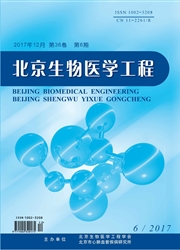

 中文摘要:
中文摘要:
目的探讨基于孤立性肺结节建立支持向量机预测模型效果,提高肺癌的早期诊断率。方法对收集的55例患者的三正交位的4135张肺结节CT图像,应用Curvelet变换进行纹理提取,对提取的476个特征值应用支持向量机进行良恶性分类并预测,应用符合率、敏感度和特异度对预测结果进行评估。结果CT图像符合率为78.0%,敏感度为88.6%,特异度为24.0%。结论Curvelet转换提取三正交位肺结节纹理,用支持向量机建立预测模型,一定程度上有助于早期发现和诊断肺癌。
 英文摘要:
英文摘要:
Objective To evaluate the prediction results of solitary pulmonary nodules using support vector machine model in order to improve the detection and diagnosis of early-stage lung cancer. Methods We collected 4135 CT images of benign or malignant solitary pulmonary nodules in three dimensions from 55 patients. Four hundred and seventy-six Curvelet transform textural features were used as parameters to establish support vector machine model, and the classification consistency, sensitivity and specificity were used to evaluate the forecast results. Results The classification consistency, sensitivity and specificity for the model were 78.0% ,88.6% and 24.0% , respectively. Conclusions Based on Curvelet transform to extract textural features, support vector machine can improve the diagnosis of early-stage lung cancer to some extent.
 同期刊论文项目
同期刊论文项目
 同项目期刊论文
同项目期刊论文
 Prediction models for solitary pulmonary nodules based on curvelet textural features and clinical pa
Prediction models for solitary pulmonary nodules based on curvelet textural features and clinical pa Contourlet textual features: improving the diagnosis of solitary pulmonary nodules in two dimensiona
Contourlet textual features: improving the diagnosis of solitary pulmonary nodules in two dimensiona Risk Profiles for Metabolic Syndrome and its Transition Patterns for the Elderly in Beijing, 1992-20
Risk Profiles for Metabolic Syndrome and its Transition Patterns for the Elderly in Beijing, 1992-20 Support Vector Machine Prediction Model of Early-stage Lung Cancer Based on Curvelet Transform to Ex
Support Vector Machine Prediction Model of Early-stage Lung Cancer Based on Curvelet Transform to Ex 期刊信息
期刊信息
